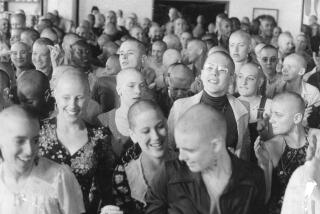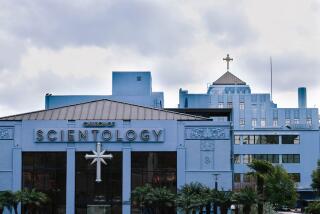THE SCIENTOLOGY STORY: A SPECIAL REPORT : About This Series
The Times today begins a six-part series on the Church of Scientology, the controversial religion founded by the late author L. Ron Hubbard.
Since its creation nearly four decades ago, Scientology has grown into a worldwide movement that, in recent months, has spent millions of dollars promoting its founder and his self-help book, “Dianetics: The Modern Science of Mental Health.”
In the past five years alone, more than 20 of Hubbard’s fiction and nonfiction books have become national bestsellers--most of them achieving that status after his death in January, 1986.
Scientology executives estimate the church’s membership to be more than 6.5 million, although some former members believe the actual number is smaller.
Scientology’s largest stronghold is in Hollywood, the organization’s management nerve center. The church is also a major presence in Clearwater, Fla., where Scientologists from around the world go for training.
No other contemporary religion has endured a more turbulent past or a more sustained assault on its existence than the Church of Scientology. It has weathered crises that would have crippled, if not destroyed, other fledgling religious movements--testimony to the group’s determination to survive.
Eleven of its top leaders--including Hubbard’s wife--were jailed for burglarizing the U.S. Justice Department and other federal agencies in the 1970s. Within the church, there have been widespread purges and defections. Some former members have filed lawsuits accusing the church of intimidating its critics, breaking up families and using high-pressure sales techniques to separate large sums of money from its followers.
In 1986, Scientology paid an estimated $5 million to settle more than 20 of the suits, without admitting wrongdoing. In exchange, the plaintiffs agreed never again to criticize Scientology or Hubbard and to have their lawsuits forever sealed from public view.
Through all this, the church has persevered, dismissing its critics in government, psychiatry and the media as “criminals” and “anti-religion” demagogues who have conspired to persecute Scientology.
Today, the Scientology movement is writing a new chapter in its history, one that has attracted a new generation of supporters and detractors. Through official church programs and a network of groups run by Scientology followers, the movement is reaching into American society as never before to gain legitimacy and new members.
The apparent intent is to position Hubbard as a sort of 20th-Century Renaissance man, lending new credibility to his Scientology teachings.
Among other things, church members are disseminating his writings in schools across the U.S., assisted by groups that seldom publicize their Scientology connections.
Scientology followers also have established a number of successful consulting firms that sell Hubbard’s management techniques to health care professionals and businessmen. In the process, many are steered into the church.
And Scientologists are the driving force behind two organizations active in the scientific community. The organizations have been busy trying to sell government agencies and the public on a chemical detoxification treatment developed by Hubbard.
There is little question that, although Hubbard is gone, Scientology is here to stay--and doing its best to meet his expectations. “The world is ours,” he once told his adherents. “Own it.”
More to Read
Sign up for Essential California
The most important California stories and recommendations in your inbox every morning.
You may occasionally receive promotional content from the Los Angeles Times.










